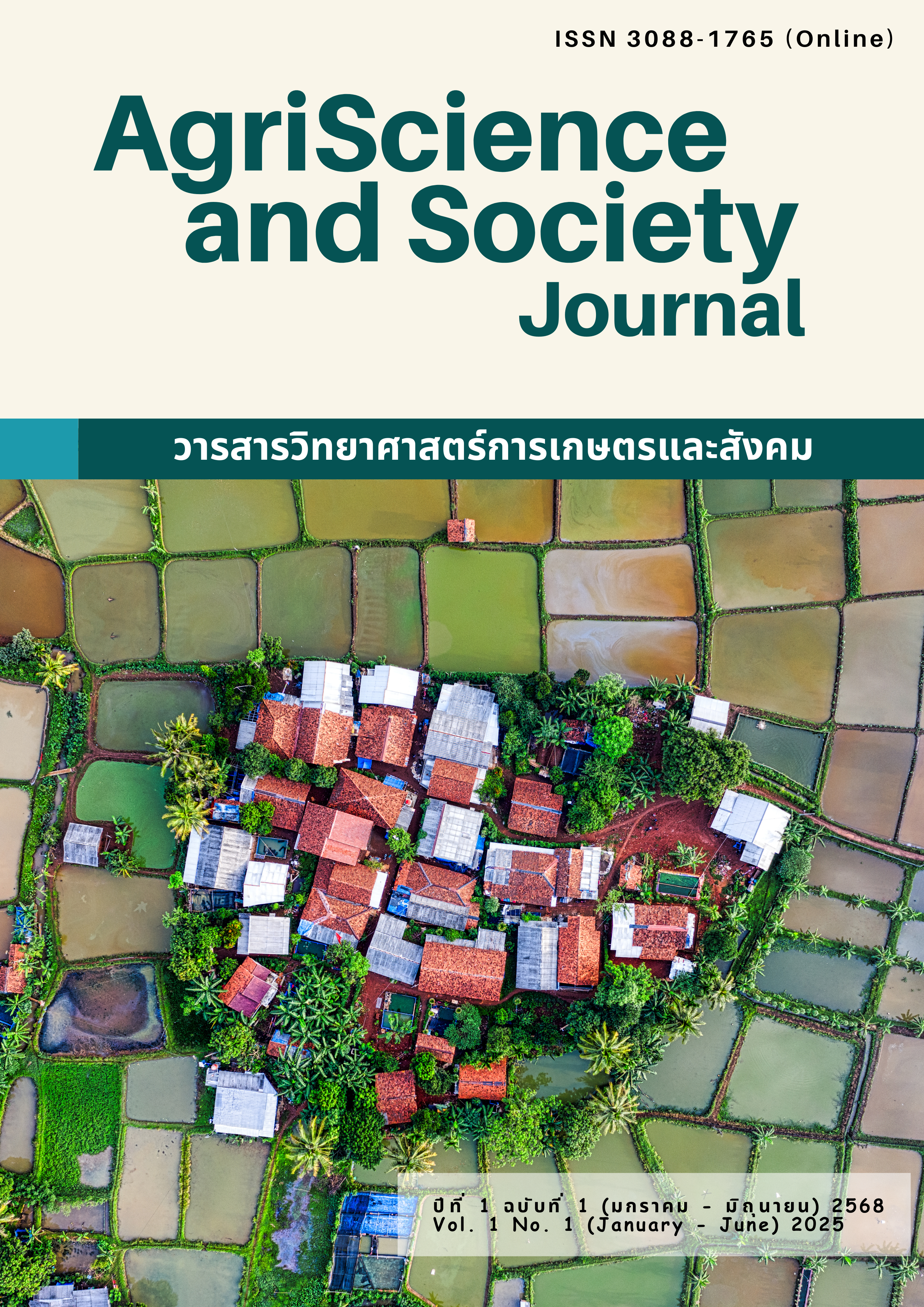การวิเคราะห์ความหลากหลายทางพันธุกรรมและการจำแนกไพลดำ (Zingiber ottensii Valeton) ในประเทศไทยด้วยเครื่องหมายโมเลกุล
คำสำคัญ:
ไพลดำ , SSR, ความหลากหลายทางพันธุกรรม , การจำแนกบทคัดย่อ
ไพลดำ (Zingiber ottensii Valeton) จัดเป็นพืชสมุนไพรท้องถิ่นที่พบได้มากทางภาคใต้ของประเทศไทย เป็นพืชในวงศ์ขิง (Zingiberaceae) ซึ่งมีซีรัมโบน (zerumbone) ในน้ำมันหอมระเหยเป็นองค์ประกอบหลัก มีฤทธิ์ต้านแบคทีเรียและไวรัส ต้านมะเร็งและลดการอักเสบ งานวิจัยนี้ศึกษาความหลากหลายทางพันธุกรรมและการจำแนกไพลดำด้วยเครื่องหมายโมเลกุล โดยการเก็บรวบรวมไพลดำในประเทศไทย 34 ตัวอย่าง และพืชสกุลขิงชนิดอื่น ๆ (Zingiber spp.) 19 ตัวอย่าง ตรวจสอบโดยใช้เครื่องหมาย Single Sequence Repeat (SSR) จำนวน 58 คู่ไพรเมอร์ ซึ่งพบว่า ไพรเมอร์จำนวน 33 คู่ไพรเมอร์ สามารถเพิ่มปริมาณดีเอ็นเอด้วยเทคนิคพีซีอาร์ได้ และมีไพรเมอร์จำนวน 14 คู่ไพรเมอร์ ที่สามารถจำแนกความแตกต่างของแถบดีเอ็นเอในไพลดำและพืชสกุลขิงชนิดอื่นได้ โดยมีจำนวนแอลลีลทั้งหมด 150 แอลลีล ค่าเฉลี่ย 10.71 แอลลีลต่อไพรเมอร์ เมื่อวิเคราะห์ความหลากหลายทางพันธุกรรมด้วยวิธีการจัดกลุ่มแบบ UPGMA พบว่า สามารถจัดกลุ่มความสัมพันธ์ทางพันธุกรรมได้เป็น 3 กลุ่ม กลุ่มที่ 1 เป็นตัวอย่างไพลดำทั้งหมด กลุ่มที่ 2 ประกอบด้วย กระทือ (Z. zerumbet), ขิงดอกลาย (Z. flavomaculosum), ไพลเหลือง (Z. montanum) และ ขิงภูพาน (Z. parishii) และกลุ่มที่ 3 ได้แก่ ขิง (Z. officinale) มีค่าสัมประสิทธิ์ความคล้ายคลึงกันทางพันธุกรรม อยู่ระหว่าง 0.57 – 1.00 และมีค่าเฉลี่ย 0.83 โดยไพลดำทั้งหมดมีค่าสัมประสิทธิ์ความคล้ายคลึงกันทางพันธุกรรมสูงสุด (1.00) แสดงให้เห็นว่า ไพลดำในประเทศไทยมาจากแหล่งที่มาเดียวกันและมีลักษณะทางพันธุกรรมเหมือนกัน เนื่องจากการขยายพันธุ์ของไพลดำนิยมใช้เหง้าซึ่งเป็นการขยายพันธุ์แบบไม่อาศัยเพศ ทำให้ได้ต้นใหม่ที่มีลักษณะพันธุกรรมเหมือนต้นแม่ และพบเครื่องหมาย ZOSSR25 ที่สามารถจำแนกไพลดำออกจากพืชสกุลขิงอื่น ๆ ได้อย่างถูกต้องและมีประสิทธิภาพ ดังนั้นเครื่องหมายโมเลกุล SSR เป็นเทคนิคที่มีความแม่นยำและรวดเร็ว และนำมาใช้ตรวจสอบเพื่อจำแนกไพลดำได้ตั้งแต่ระยะต้นกล้า
เอกสารอ้างอิง
Surin Piyachoknagul. (2009). DNA markers: From basic principles to applications. Bangkok: Kasetsart University Press.
Awasthi, P., Singh, A., Sheikh, G., Mahajan, V., Gupta, A.P., Gupta, S., Bedi, Y.S., and Gandhi, S.G. (2017). Mining and characterization of EST-SSR markers for Zingiber officinale Roscoe with transferability to other species of Zingiberaceae. Physiology and Molecular Biology of Plants, 23(4), 925–931. https://doi.org/10.1007/s12298-017-0472-5
Das, A., Gaur, M., Barik, D.P., and Subudhi, E. (2017). Genetic diversity analysis of 60 ginger germplasm core accessions using ISSR and SSR markers. Plant Biosystems, 151(5), 822–832. https://doi.org/10.1080/11263504.2016.1211197
Faridah, Z., Abdelmageed, A.H.A., Julia, A.A., and Hafizah, R. (2011). Efficient in vitro regeneration of Zingiber zerumbet Smith (a valuable medicinal plant) plantlets from rhizome bud explants. African Journal of Biotechnology 10, 9303–9308. https://doi.org/10.5897/AJB11.1182
Gawel, N.J., and Jarret, R.L. (1991). A modified CTAB DNA extraction procedure for Musa and Ipomoea. Plant Molecular Biology Reporter 9, 262–266. https://doi.org/10.1007/BF02672076
Lee, S.Y., Fai, W.K., Zakaria, M., Ibrahim, H., Othman, R.Y., Gwag, J.G., Rao, R., and Park, Y.J. (2007). Characterization of polymorphic microsatellite markers, isolated from ginger (Zingiber officinale Rosc.). Molecular Ecology Notes 7, 1009–1011. https://doi.org/10.1111/j.1471-8286.2007.01757.x
Ly, S., Truong, V., and Huong, Le. (2016). Zingiber ottensii Valeton (Zingiberaceae) – a newly recorded species for Vietnam. Bioscience Discovery 7, 93–96.
Mohamed S.A., Hussein, S.T., Usama, I.A., Hattem, M.E., and El-Sayed I.G. (2011). In vitro propagation of ginger (Zingiber officinale Rosco). Journal of Genetic Engineering and Biotechnology, 9, 165–172. https://doi.org/10.1016/j.jgeb.2011.11.002
Mondini, L., Noorani, A., and Pagnotta, M.A. (2009). Assessing plant genetic diversity by molecular tools. Diversity, 1, 19–35. https://doi.org/10.3390/d1010019
Panyajai, P., Chueahongthong, F., Viriyaadhammaa, N., Nirachonkul, W., Tima, S., Chiampanichayakul, S., Anuchapreeda, S., and Okonogi, S. (2022). Anticancer activity of Zingiber ottensii essential oil and its nanoformulations. PLoS One, 17, e0262335. https://doi.org/10.1371/journal.pone.0262335
Rohlf, F.J. (2002). NTSYSpc Numerical Taxonomy and Multivariate Analysis System. New York: Applied Biostatistics.
SaiSug, W., and Ukoskit, K. (2013). Comparative analysis of EST-derived markers for allelic variation in Jatropha curcas L. and cross transferability among economically important species of Euphorbiaceae. Genes & Genomics 35, 1–12. https://doi.org/10.1007/s13258-013-0064-x
Sharifi-Rad, M., Varoni, E.M., Salehi, B., Sharifi-Rad, J., Matthews, K.R., Ayatollahi, S.A., Kobarfard, F., Ibrahim, S.A., Mnayer, D., Zakaria, Z.A., Sharifi-Rad, M., Yousaf, Z., Iriti, M., Basile, A., and Rigano, D. (2017). Plants of the genus Zingiber as a source of bioactive phytochemicals: from tradition to pharmacy. Molecules, 22(12), 2145. https://doi.org/10.3390/molecules22122145
Sirat, H.M. (1994). Study on the Terpenoids of Zingiber ottensii. Planta Medica, 60, 497.
Singh, S.P., Nongalleima, K., Singh, N.I., Doley, P., Singh, C.B., Singh, T.R., and Sahoo, D. (2018). Zerumbone reduces proliferation of HCT116 colon cancer cells by inhibition of TNF-alpha. Scientific Reports, 8, 4090. https://doi.org/10.1038/s41598-018-22362-1
Triboun, P., Larsen, K., and Chantaranothai, P. (2014). A key to the genus Zingiber (Zingiberaceae) in Thailand with descriptions of 10 new taxa. Thai Journal of Botany, 6(1), 53–77.
Vidya, V., Prasath, D., Snigdha, M., Gobu, R., Sona, C., and Maiti, C.S. (2021). Development of EST-SSR markers based on transcriptome and its validation in ginger (Zingiber officinale Rosc.). PLoS One 16(10), e0259146. https://doi.org/10.1371/journal.pone.0259146
ดาวน์โหลด
เผยแพร่แล้ว
รูปแบบการอ้างอิง
ฉบับ
ประเภทบทความ
สัญญาอนุญาต
ลิขสิทธิ์ (c) 2025 Natural Resources

อนุญาตภายใต้เงื่อนไข Creative Commons Attribution-NonCommercial-NoDerivatives 4.0 International License.
วารสารทรัพยากรธรรมชาติและวิทยาศาสตร์การเกษตร อยู่ภายใต้การอนุญาต Creative Commons Attribution-NonCommercial-NoDerivatives 4.0 International (CC BY-NC-ND 4.0) เว้นแต่จะระบุไว้เป็นอย่างอื่น โปรดอ่านหน้านโยบายของเราสำหรับข้อมูลเพิ่มเติมเกี่ยวกับการเข้าถึงแบบเปิด ลิขสิทธิ์ และการอนุญาต






